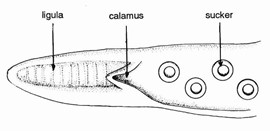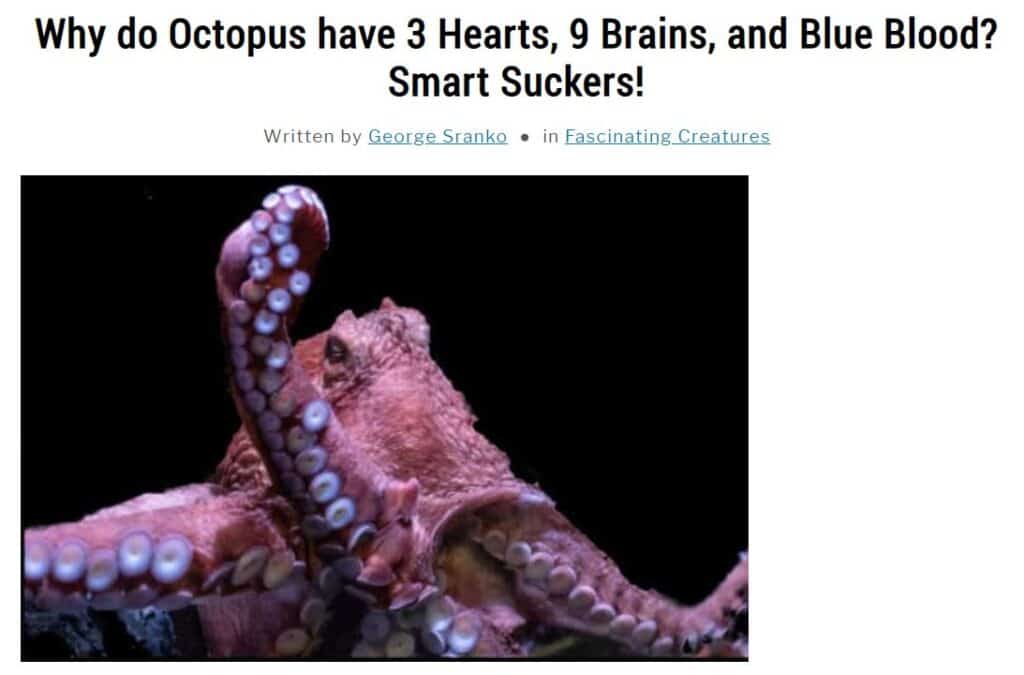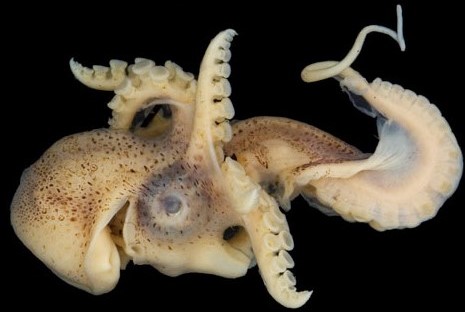I have written this article to give wider exposure to some fascinating scientific insights into the complicated mating habits of octopuses.
Most male octopus have a specialized extra-long arm called the hectocotylus to deliver sperm from a distance. This is an adaptation to mating with cannibalistic females that frequently kill and eat males during or after sex. One octopus, the nautilus, has a worm-like hectocotylus that functions like a detachable phallus that can swim to the female on its own.
Read on if you want to learn about some of the craziest sex in the natural world!
There are nearly 300 species of octopus in the world, ranging from the giant pacific octopus that can stretch up to 30 feet across to the tiny wolfi octopus, less than one inch in size. They have a wide variety of mating habits and I can’t cover them all; but I can explore some of the more intriguing aspects of sex in the world of Cephalopods!
The Risks of Mating with a Cannibalistic Female
The urge to mate and pass-on genes is a biological imperative and males of many species must often take great risks to successfully mate with a female. To accomplish this, the male octopus must deposit his sperm inside the female’s body, at very real risk to his life.
In the case of octopuses, females are usually larger than males and can view them as both potential mate… and tasty titbit!
In most species of octopus, males have an intriguing adaptation; a modified arm for delivering sperm called the hectocotylus. An extra-long organ makes sense as a survival strategy when mating with hungry females! Researchers have determined that it is relatively common for females to kill males during or after sex. Often, the female will carry the inert body of the male into her den for a quiet meal. In this scenario, it is not just sperm that the male donates, but a nice heaping helping of protein to tide the female over during the often-extended period of laying and tending to her eggs.
Excellent video showing mating octopuses
Females can Store Sperm until the Time is Right
Females can store sperm in specialized compartments inside their mantle. When it is time to lay the eggs, they pass through the oviducal gland and are fertilized.
Do Octopuses have Erections? How does the Hectocotylus Work?
The hectocotylus is a modified sex arm with a central groove, or calamus, that holds packets of sperm called spermatophores. The tip of the arm features erectile tissue called the ligula, like that found in the human penis.
This means that male octopuses can get erections.
Octopuses are the first soft-bodied animals known to have erectile tissue. In structure, the ligula is remarkably similar to mammal penises and clitorises. When an octopus becomes aroused, cavities in the erectile tissue get filled with blood and the ligula is inflated.
When the ligula is inflated, it provides sufficient stiffness to guide the arm into in one of the two siphons on the female’s mantle. Ligula can have a dual purpose. Males can also use their ligulas to remove sperm from competing males that have previously mated with a female. A handy tool indeed!


Both females and males can have more than one mate
During courtship both females and males use appearance to find attractive mates. Males are looking for a large female that will produce more eggs, providing the male with a greater probability of passing on his genes. Females are looking for a male with a large ligula. The ligula will become enlarged with attraction and the male can try to woo the female with intricate color flashes and skin displays. Her response will indicate if she’s ready and willing to mate.

During sex, the male releases his spermatophores into the female’s small oviduct, a sort of holding area for storing sperm. When the female lays her eggs, in some cases days or even months later, they will pass by this area and become fertilized.
The trick for the male is to prolong the encounter long enough to transfer at least one spermatophore, and preferably more. In some smaller species this might take just a couple minutes, but for big species like the Giant Pacific Octopus (Enteroctopus dofleini), mating can last up to four hours or more.
Of course, there are downsides to having a prolonged mating encounter! First, a female can suddenly switch from mating to trying to turn the male into dinner, and second, they both become more vulnerable to predators while preoccupied.
If you find Octopuses fascinating – read my related article to discover why they have 3 hearts and 9 brains!

Octopuses mating…??
Is this a mating attempt gone wrong? Sometimes they all look alike!
In fact, the male algae octopus (Abdopus aculeatus) approaching the female’s den is in for a big surprise! Turns out that the octopus he wanted to mate with is not a female after all, but a big male guarding the female’s den. A fight ensues between the two males and after a wild flurry of sixteen arms, the inquisitive one jets off in hasty retreat.
Sex Means the End is Near for an Octopus
For males, mating triggers a quick decline in health as they enter a period of senescence, and death within a matter of days or weeks. Females can live for several months after mating; laying eggs and protecting them until they hatch (amazingly they do so without eating until they die).

The Benefits of an Extra-long Sex Appendage
Over millions and millions of years natural selection, male octopus have evolved creative solutions to mating with potentially cannibalistic females. One approach is for the male to find a good spot near the den of one or more females so he can create his own den in a convenient location close by.
The trick is to have a female or two within reach of his extra-long hectocotylus without having to leave the den. This way the male can stay in the safety of his own den while reaching around the corner with his specialized sex appendage to try and deliver a packet of sperm to a nearby female.
(I won’t even try to anthropomorphize about the advantages of having such a handy tool! Which brings me to another fascinating adaptation – the detachable penis!!)
An octopus gets to mate only once in its life… and then it dies! The life of an octopus can be so unfair!
True Tales of the Argonaut and his Detachable Penis
The Argonaut (Argonauta argo) is a unique species of octopus that lives in the open tropical oceans. The male is tiny—less than three-quarters of an inch long—while the female can be up to 30 times his size.
Female argonauts have two specialized dorsal arms that secrete a chalky substance, forming a pleated shell in which she can hide, float, and brood eggs. Males have no shell, but they do have a unique hectocotylus: a tentacle-like, detachable copulatory organ.
Mating in argonauts is very unusual. When a tiny male argonaut encounters a female, he ruptures a pouch containing his specialized hectocotylus. He loads his arm with sperm, then detaches it from his body. At this stage, the hectocotylus is independent, and the male can pass it over to the female or he can just let the arm swim to the female on its own.
It’s interesting to note that each arm of an octopus has a brain of its own along with the ability to act independently even when separated from the body (see my related article on octopus brains).

The detached arm crawls under its own power into the gill cavity of the female where it attaches to her gills and is stored until it is required for fertilization. Some females have been found with a collection of disembodied sperm arms stockpiled from several mates inside their gill cavities.
Once the timing is right, the female will lay strings of eggs tethered to her shell where she can look after them as they develop.
Once the male argonaut’s copulatory organ is detached, it is believed that the male dies. Scientists have never found a male alive without his reproductive arm. (Did you know that male seahorses become pregnant, instead of the females.)
As his last act, the small but mighty argonaut male gives his arm and his life to fulfil his biological imperative; to pass on his genes. (Thunderous applause please!)
Another Amazing Octopus Ability – Regenerating Lost Appendages!
The octopus is one of the few creatures that can regrow a completely severed or damaged appendage so that it is as GOOD as new and indistinguishable from the original. A missing arm can be completely regenerated in roughly 100 days.
Yes, regeneration also works with the all important hectocotylus!
In the case of the octopus, this means regenerating an entire mini brain from scratch! To find out more about this amazing ability take a look at my article on Octopus Regeneration.
Bonus: Do You Know the Difference between an Arm and a Tentacle?
- Octopus arms have suction cups along the entire length of the limb.
- Tentacles only have suction cups near the end of the limb.

Some Cephalopods have arms, some have tentacles, and some have both! Octopuses have eight arms, while squid and cuttlefish have eight arms and two tentacles.


Thank you for reading my article.
Check out the rest of my popular octopus articles:
Why do Octopus have 3 Hearts, 9 Brains, and Blue Blood? Smart Suckers!
How Smart are Octopuses? Are Octopuses As Intelligent as Dogs?
Why do Male Octopuses Die after Mating? (How does Octopus Senescence work?)
Can Octopus Arms Grow Back? Are Regenerated Limbs Just as Good?
References
Anderson, R.C. & Cosgrove, James & Jensen, Gregory & Lewand, Kevin. (2003). Observation on mating of the giant Pacific octopuses.
CephBase: a repository of data and factual information for the Class Cephalopoda – squids, octopuses, cuttlefish and nautilus.
Museum Victoria project on Argonautsfunded by Hermon Slade Foundation and Australian Biological Resources Survey.
Thompson, J. T. & Voight, J. R. (2003) Erectile tissue in an invertebrate animal: the Octopus copulatory organ. Journal of Zoology, 261, 101 – 108 (2003).
For excellent photos showing mating octopuses go to Tonmo.com
See Our TOP Articles for Even More Fascinating Creatures
- How do Octopus Reproduce? (Cannibalistic Sex, Detachable Penis)
- How Smart are Octopuses? Are Octopuses As Intelligent as Dogs?
- Can Octopus Arms Grow Back? Are Regenerated Limbs Just as Good?
- Do Jellyfish have Brains? How Can they Hunt without Brains?
- Why are Deep Sea Fish So Weird and Ugly? Warning: Scary Pictures!
- Are Komodo Dragons Dangerous? Where Can you See Them?
- Koala Brains – Why Being Dumb Can Be Smart (Natural Selection)
- Why do Lions Have Manes? (Do Dark Manes Mean More Sex?)
- How Do Lions Communicate? (Why Do Lions Roar?)
- How Dangerous are Stonefish? Can You Die if You Step on One?
- What Do Animals Do When They Hibernate? How do they Survive?
- Leaf Cutter Ants – Surprising Facts and Adaptations; Pictures and Videos
- Irukandji Jellyfish Facts and Adaptations; Can They Kill You? Are they spreading?
- How to See MORE Wildlife in the Amazon: 10 Practical Tips
- Is it Safe to go on Safari with Africa’s Top Predators and Most Dangerous Animals?
- What to Do if You Encounter a Bullet Ant? World’s Most Painful Stinging Insect!
- How Do Anglerfish Mate? Endless Sex or Die Trying!
- How Smart are Crocodiles? Can They Cooperate, Communicate…Use Tools?
- How Can We Save Our Oceans? With Marine Sanctuaries!
- Why Are Male Birds More Colorful? Ins and Outs of Sexual Selection Made Easy!
- Why is the Cassowary the Most Dangerous Bird in the World? 10 Facts
- How Do African Elephants Create Their Own Habitat?
- What is Killing Our Resident Orcas? Endangered Killer Whales
- Why are Animals of the Galapagos Islands Unique?
- Where Can You See Wild Lemurs in Madagascar? One of the Best Places
- Where Can You see Lyrebirds in the Wild? the Blue Mountains, Australia
- Keeping Mason Bees as Pets
- Why do Flamingos have Bent Beaks and Feed Upside Down?
- Why are Hippos Dangerous? (Do They Attack People?)
The Gear We Take With Us
We love to travel in search of exceptional wildlife viewing opportunities and for life-enhancing cultural experiences.
Here is the gear we love to travel with for recording our adventures in safety and comfort:
- Action Camera: GoPro Hero10 Black – we find these waterproof cameras are invaluable for capturing the essence of our adventures in video format. Still photos are great, but video sequences with all the sights and sounds add an extra dimension. I use short video clips to spice up many of my audiovisual presentations.
- Drone: DJI Mini 2 SE – this mini drone is made for travel! Roughly the same weight as a smartphone. In the United States and Canada, you can fly this drone without the need to register with local government. Capture on the Go – The lightweight and powerful DJI Mini SE camera drone is the ideal for creators on the move. The ultra-portable design allows you to effortlessly capture unforgettable scenes.
- Long Zoom Camera: Panasonic LUMIX FZ300 Long Zoom Digital Camera – I love this camera for its versatility. It goes from wide angle to 28X optical in a relatively compact design. On safari in Africa I’ve managed to get good shots of lions that the folks with long lenses kept missing – because the lions were too close! I also like the 120 fps slow-motion for action shots of birds flying and animals on the move. I call this my “bird camera.”
- 360 Camera: Insta360 ONE R 360 – 5.7K 360 Degree Camera, Stabilization, Waterproof – see my article How to Take Impossible Shots with Your 360 Camera. This camera is literally like taking your own camera crew with you when you travel! Read my article and you’ll see why.
- Backpack camera mount: Peak Design Capture Clip
- Water Filtration: LifeStraw Go Water Filter Bottle
- Binoculars: Vortex Binoculars or Vortex Optics Diamondback HD Binoculars (good price)

